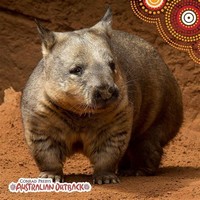Facts about Wombat

Modern wombats tend to be solitary individuals, but many animals may share the same warren, although it appears they occupy different sections (Johnson 2004).

The name wombat comes from the Eora Aboriginal community who were the original human inhabitants of the Sydney area.

Wombats, like all the larger living marsupials, are part of the Diprotodontia.

Wombats can be awkwardly tamed in a captive situation, and even coaxed into being patted and held, possibly becoming quite friendly.

Modern wombats are the culmination of a Vombatidae lineage that traces back millions of years, to the early Miocene, with a number of species present during the Pleistocene, including some very large wombats.

Wombats have an extraordinarily slow metabolism, which aids their survival in arid conditions (McIlroy 1984).

Wombats do not figure strongly in Aboriginal mythology, and lack positive commercial value for humans (they are sometimes regarded as agricultural pests) (Johnson 2004).

The large intestine of wombats is large and hosts cellulose-digesting microorganisms, and food is held in their for long periods (seventy hours or longer), allowing breakdown of fiber (Johnson 2004).

The incisor teeth of wombats somewhat resemble those of the placental rodents, being adapted for gnawing tough vegetation, as well as for digging tunnels.

The northern hairy-nosed wombat is extremely rare and found in only one locality in Australia.

Wombats are valued components of the food chains in their Australia ecosystems, eating grasses and other vegetative material, and being preyed upon by dingos and Tasmanian devils.

The sheer weight of a wombat makes a charging wombat capable of knocking an average-sized man over, and their sharp teeth and powerful jaws can result in severe wounds.

When attacked, wombats can summon immense reserves of strength; one defense of a wombat against a predator underground is to crush it against the roof of the tunnel.

Modern wombats dig extensive burrow systems with rodent-like front teeth and powerful claws.

The earliest fossil records of wombats are from the early Miocene (Johnson 2004), about 20 million years ago.

The common wombat occupies a range of up to 23 hectares (57 acres), while the hairy-nosed species have much smaller ranges, of no more than four hectares (ten acres) (McIlroy 1984).

Some fossil wombats were much larger, including Phascalonus gigas that weighted an estimated 200 kilograms and stood a meter high (Johnson 2004).

Wombats defend home territories centered on their burrows, and react aggressively to intruders.

The common wombat has a naked snout, while the two hairy-nosed wombat species have a hairy covering over the rhinarium, as well as longer pointed ears and finer fur (Johnson 2004).

Modern wombats are all thick-set, burrowing herbivores, with short and muscular legs, an insignificant tail, a broad massive head with small ears (Johnson 2004).

The ancestors of modern wombats evolved sometime between 55 and 26 million years ago (no useful fossil record has yet been found for this period).

Among the several rhinoceros-sized giant marsupial species was the largest marsupial to have ever lived, Diprotodon, related to the wombat, being in the same suborder (Vombatiformes) but different family.

Wombats generally move slowly, but when threatened they run quite fast for short periods.

Many parks, zoos and other tourist set-ups across Australia have wombats on public display, and are quite popular.

The modern wombats are about one meter (39 inches) in size and weigh between 25 and 40 kilograms (55 to 88 pounds).

The common wombat occupies a range of up to 23 hectares (57 acres), while the hairy-nosed species have much smaller ranges, of no more than four hectares (ten acres) (McIlroy 1984).

Wombat is the common name for any of the stocky Australian marsupials comprising the family Vombatidae, characterized by short legs, very short tails, large head, and small ears.

Female wombats give birth to a single young in the spring, after a gestation period lasting about 22 days (Johnson 2004).

Wombats are weaned after 15 months, and are sexually mature at 18 months of age (McIlroy 1984).
